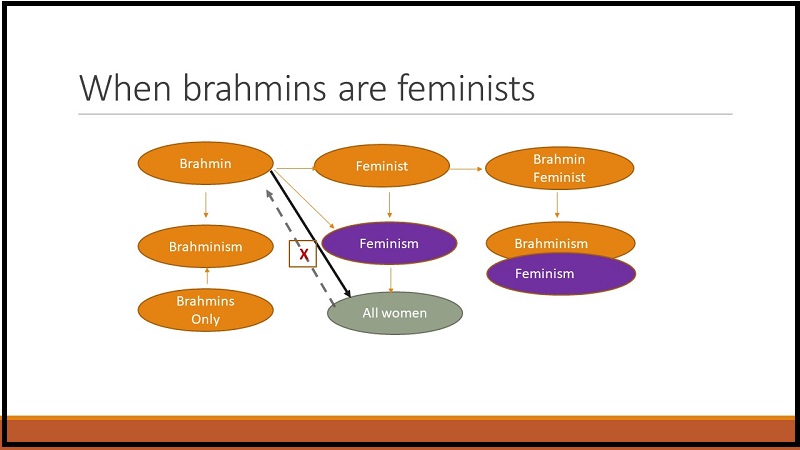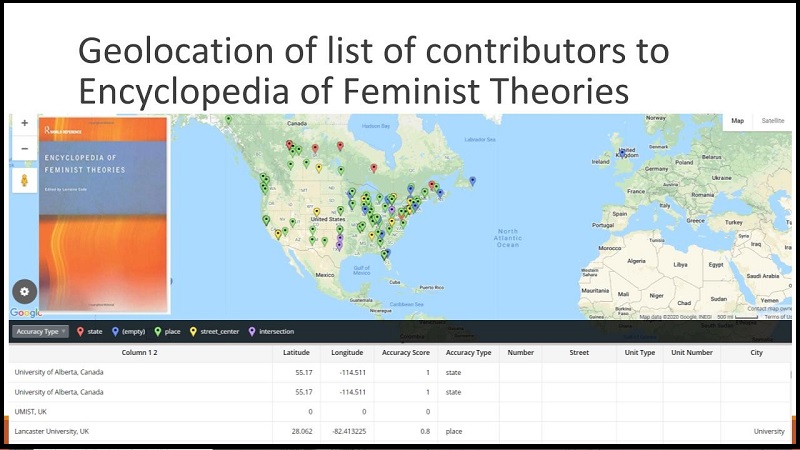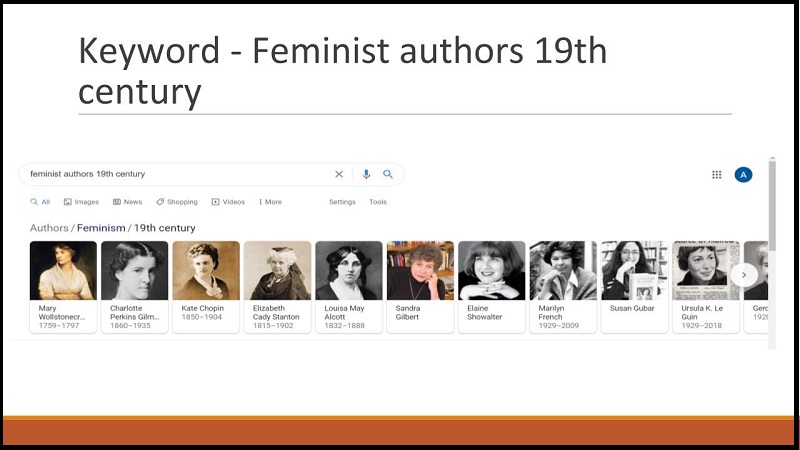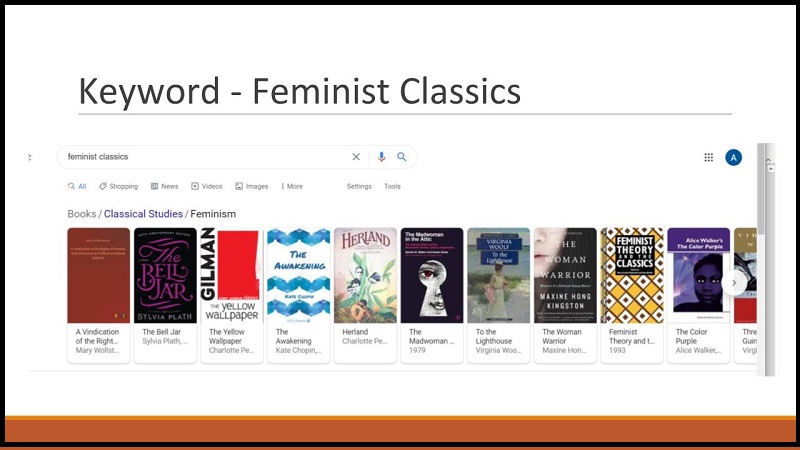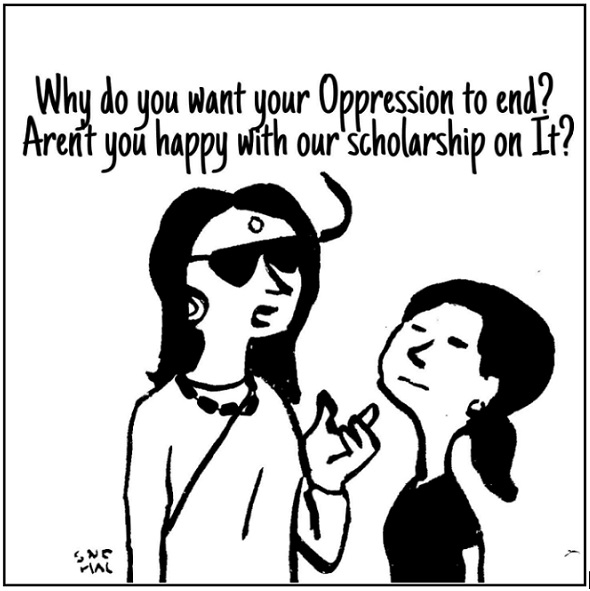Anu Ramdas
This is the transcript of a preliminary talk on the topic of feminism is brahminism.
First, thank you. It is so lovely to see all of you. Thank you for the opportunity. And I am not at all happy to be talking about this topic at such a time. Ever since I wanted to understand caste, every time I tried to frame a question, I would be tripped up by someone saying that it is clashing with feminism. That is not the way to ask because that’s not the right question. The right question is one where you have to center the woman alone. So I could not even start a conversation about caste without traversing the obstacles placed by feminism. And the way it presented itself, at every step it started becoming more complex. First I had to know the words, then I had to know from where those words came, what were the sources and why was it so necessary for me to use this language in order to get to caste. And why did I not know feminism before that?
A little bit of background about me: I grew up in a cosmopolitan city, Bangalore. I studied mostly in Christian institutions, mostly girls’ institutions. I studied in a girls school, I went to a girls’ college and then MSc,.. during all this time, as a girl, as a teenager, as a young woman, I never needed the word feminism to get through life. It is only after I entered university that this becomes almost central to how I have to resolve things, how I am asked to identify things; everything is supposed to be through feminism. So, it seemed to me like I could not do anything unless I really made an effort to read up on feminism. I was pressured to know what this subject is. And I kept on thinking because I come from a science background, I have not gained what appears to be common sense. Everybody knows what feminism is and it is only me who doesn’t know about this. So I have to put in this extra effort to read so that I am able to follow what others are saying, what my peers are saying and once I get there then I’ll be able to ask questions about caste.
So, when I was in university I would go to the humanities section in the library. I had no actual business there. I was a science student and I had enough of my own work. But in order to understand this word feminism I used to go looking for material in the libraries at HCU, University of Pune, and later on at Cornell University where I spent more than 13 years. Every spare minute that I had I was looking at the feminist literature section. Cornell university is a very well-funded place. It has several libraries: huge shelves of books, so much of feminist literature and none of them made any sense to me at any level – the names, the topics.
[As I read these books] again, and again I am being told that this is about women’s rights. And I am looking at huge aisles of books, which means knowledge at the most sophisticated end, a knowledge system that has fully materialized. A book, when it appears, has gone through a very long line of structures that have facilitated that. Not only has it become a book, but it has also appeared in a university library. So, if you are a science student you understand how that process happens. For a new area to become a book and then find a place in the library it is a very long process. Here it seemed like feminism.. what do you say..is a pretty old subject. If that is true, it is only a matter of time before I locate that part of feminist literature which would speak to me, where women of the world have contributed to that knowledge. It’s just me who is not finding that literature. I also spend a lot of time in book shops, mostly secondhand book shops. Every time I go, I look at the women’s section. I think because I am in a foreign country because I am not in India I am not accessing Indian feminist books that will bring me closer to the caste question.
In the bookshops, I see there are no African-American writers on the shelves that have feminist literature. And I ask the store managers about it. He says oh sorry Ma’am we actually keep those books under African-American writers section. They are women writers, they are feminist writers but they have no place there. And then when I go there it is maybe two or three books as compared to the shelves holding the white women authors, which is a massive collection and every time there are new books. Because all the bookshops will always have the new books upfront and you’ll always have a couple of feminist books out there. So, it was very clear here the oppositional feminist literature’s (Black) production rates were very different. The number of black feminist authors who were able to produce books was no match to the volume and speed at which the white feminists were publishing.
Then I really sat down and read. Black feminist literature seemed a little closer to what I was looking for. But over the years I realized that it is not true. I spent a lot of time reading them. And of course, there was no reflection of me or the women that I know in the black feminist literature or in the white feminist literature. But I was still hoping through these journeys that I will understand that all this is about women’s rights. That all these women produced this vast amount of knowledge and some of it has been responsible to make my rights possible. They have all worked for it. And I should just find it and I am going to find it. But in real life that was not the story. The person who worked to make education possible for my family was my paternal grandaunt. It was my paternal grandaunt who took decisions about her children having to go to college and through her effort and clarity of thought the family begins to have education as a benchmark we need to get. She is the person that I associate, in my life, with education. But feminism is telling me it is not her, it’s all these other women. So, either my grandmother (aunt) is a feminist and her role is documented in that feminist literature or they are disconnected. This reality and the materialized feminist knowledge and my real life have no connection. That is the first part of the journey.
As I started writing about it in my blog and then later on in Savari and RTI (Round Table India), which is more a collective learning kind of process, every article that appeared on Savari was a result of conversations between several members: Pradnya Jadhav, Pradnya Mangla, Sruthi, Noel, the authors, and many more Dalit Bahujan and Adivasi women. Each of those articles is a collective effort of how we were trying to understand issues. Again, most of us found the word feminism to be irrelevant. I still found it to be an obstacle for my quest to understand caste. I kept on writing updates and often people would say why don’t you just write a book. And I would tell them – no that’s a waste of my time. I don’t want to be doing that. I want to understand caste.
One day, I wrote an update and at the end of it, I wrote: Feminism is Brahminism. And I signed out thinking I am going to have a violent, very strong reaction to this from the Savarna feminists, feminists who have read and who are familiar with feminist literature and they are going to say – this lady has just lost it; she has put in a sentence two completely oppositional concepts. This is ridiculous. But I am seeing until today there hasn’t been any views strongly opposing it. That is beside the point.
Today what I want to do is quickly examine it as an absurd statement. Feminism is Brahminism is absurd on the face of it. Yes or no, I would like to hear from you at this point. There was only one young man who appeared on my wall and said that’s crazy, how can you say that! Now, how many people in this group thought of that? Please unmute and tell me, I’d be very happy to hear it. Anyone? Sruthi?
Shruti: Hi, Anu. So, I wasn’t very surprised when I read that. But if I had read that, let’s say four or five years ago I might have been surprised and taken aback. Especially, if I had read it right after university it must have bugged me at that time. We are speaking at a very different point now but I am sure it came as a surprise to a lot of people but feminism is generally seen as something very radical. Especially on campuses being a feminist is the ultimate radical position. So yeah..I’ll let you get back.
Anu: Here what I did was I put down a series of questions and I’ll quickly go through that and then you can come in and post the questions or unmute and talk to me. I am sorry that I am not able to share the PowerPoint. I’ll share the link later. This statement ‘feminism is brahminism’ did not exist in the world, I put it there. These two concepts have never been brought together in a sentence. So, let me make that very clear. The next 30-40 minutes is for us to say yes it should not exist, it’s completely wrong. Let’s see if we can do that.
Feminism is Brahminism is like oranges and apples comparison. You don’t put two different objects to compare. In order to compare something, there has to be some commonality. How can two terms be equated in a sentence? For that, you have to identify some fundamental property of each concept. In these two things Feminism is Brahminism or Feminism and Brahminism, what are the fundamental properties that they have? Are they about humans?
The word feminism is opaque. It is not self-evident that it is about humans. You are supposed to know that fem is something about females. Brahminism is upfront. It is about Brahmin and Brahmin is something related to a human. For today’s exercise, let’s just say both these concepts are about humans.
Feminism is something about women and “women are humans”. And for the other concept, Brahminism is something about Brahmins, and “Brahmins are humans”.
That would take us back to the presupposition that led to that formulation.
No one is born a feminist or a Brahmin or anything. These are learned socialized behavioral patterns. So, if that is the case what can be the factor that is common to all humans. What is the one thing that we can say is common? There are many ways that we can list what is common, but I am going to say, for today, all humans are born 7-9 months after conception. That is the baseline that I am going to take. With that, I am going to compare these two concepts.
Post-birth social constructs determine what we become. We are all born equally as humans but social constructs after birth decide what we identify ourselves as or how we are identified.
So that leads us to the question of when does a Brahmin become a Brahmin post-birth? The answer would be right away if not even before that.
When does a feminist become a feminist post-birth? Is it when she is young or is it when she is a teenager? At what point does a feminist actually become a feminist? As far as my observation goes it is usually university-educated women who can become feminists.
As far as Brahmins go, we know clearly that they belong to a human group because they belong to countable demography and they also have a geo-location within the caste society.
Now with respect to feminists, do we have an understanding of what kind of demography the feminists might be? Do they belong to a region, to an ethnic group, to a class? At present we can only use the class to delimit. But do they have a location? And that’s a question that I will try to follow up in the subsequent slides.
So, what is feminism? I just grabbed the definition and copy-pasted from a Stanford university essay on feminist philosophy. “The normative: men and women are entitled to equal rights and respects. That is the norm. The descriptive part is women are currently disadvantaged with respect to rights and respect compared to men and that is the loss that they are fighting against. The struggle is to regain that loss of rights and respect that men have.”
When any group is fighting for rights that have been lost, rights available for other humans, and one group has lost it, their fight is progressive. It is radical as Sruthi said. You can’t find fault with it.
In Brahminism, there is nothing progressive. It is a fully regressive ideology or system of belief. There is nothing redeemable about it. That everybody will agree, including a Brahmin unless he is talking with (other) Brahmins.
But feminism is perceived as progressive because it deals with the rights of a group of humans. So, for our purpose today let’s say we are all agreeing that feminism is a progressive ideology. And it is an ideology that women gain at the college and university level and one of their primary achievements would be the right to education for women. It is a hard-won battle—the right to equality—that feminists have given us. This brings us back to who is my paternal grandaunt in this scheme? In my personal life, it is this grandaunt who never went to school, let alone university, the university is so far away from her life-world, she is the one who created a pipeline for education for our family. So, do I call her a feminist? If yes, where is her place in feminism? Let’s check that out using some analytical method shortly.
On the other hand, what is Brahminism? It is composed of humans that are supremacists at birth and for all times to come. In its opposition feminism is composed of a group of humans who are fighting for their lost rights, that we have already established. But Brahminism is composed of humans who are both men and women. From the earlier set of statements, half of the Brahmins can become feminists. Because they are women, they have lost rights, they can become feminists. That brings us to the questions: if half of the Brahmins are feminists, (they) are people who have lost rights, like all other women, what happens to Brahminism when half of its members are in feminism? Does it become diminished? Have these women departed from Brahminism? It’s not clear.
A Brahmin is a part of Brahminism, and it’s a fully restricted system. No one else can enter that. A feminist, who is a part of feminism is portrayed as part of a system that includes all women. Now, what is the Brahmin feminist component? What is the relationship between all women with Brahmin feminists? Do they move down to the level of other women or do the other women move up to the level of Brahmins? (see figure) We don’t know what happens. But as far as Brahmin feminists are concerned, what can we see? It seems like they remain Brahmin and they can also be feminists. In other words, they coexist with these two apparently conflicting ideologies – Brahminism and Feminism. One is progressive, one is regressive. One is supremacist, one is fighting for equality. But the Brahmin feminists seem to orbit both these spheres with no conflict whatsoever. Which is why I had the question – is it different for them?
Is Brahminism completely oppositional to feminism? The first to reject Brahminism should have been the ones who became feminists from that group. If their fight was for equality their rejection of Brahminism should have been the first. Since such a thing doesn’t seem to appear or manifest anywhere the conclusion that I make is Brahminism and feminism are perfectly in sync with each other. They coexist peacefully.
Now if you take how equality is fought for against Brahminism..we have the most beautifully articulated theory by Babasaheb that is Annihilation of Caste. Very clearly, directly, with no ambiguity, it says it’s going to annihilate Brahminism, the entire belief system. It’s going to completely flatten that. Feminism doesn’t say anything clearly. First of all, we don’t know who that is, what the demography is, where they are. The only thing we know is they are somewhere in the universities. They never seem to clearly say that feminism is going to annihilate patriarchy. For this talk here, let us assume this and say feminism annihilates patriarchy, that is the goal and that’s the method. If that is so, what happens to Brahminism? What happens to supremacism or classicism or racism? If feminism annihilates patriarchy will it mean everybody will be equal?
Or, will everybody be equal when annihilation of caste happens? Another way to frame it is – can women become equal to men when men themselves are unequal? More specifically, will the Brahmin woman become equal to the Brahmin man or Khatri man or the Dalit man? If the goal of the women in feminism is to become equal to men, what is she going to become equal to? Will the white woman become equal to the black man and vice-versa? Is the Dalit woman going to become equal to the Dalit man or to the Khatri man or to the Brahmin man? In a closer situation, for me as an immigrant worker in the USA, I can ask this question as – if I am a feminist and I believe in feminism and my fight and battle and my goal are simply to become equal to the man, I am in a society where there are white men, brown men, and Asian men. So as an immigrant worker I am going to become equal to which group of these men and how do I become that?
Following are a set of questions for all of us to use to see if I was wrong in saying that feminism is Brahminism. I have laid out all the tools with which you can say – because all your answers to these questions came out affirmative or negative, end result is feminism is progressive and Brahminism is regressive and the two can’t be equated.
Theoretically, even if I manage to convince someone or simply because no one bothers to interact with me, they did not come out and say you are talking rubbish and all these questions are also too abstract for them, I need to provide concrete evidence to back up what I said.
How can I build a set of evidence for this, given that I have said that feminism seems to be a product at the university level and (it has to be engaged with through extensive and dedicated assimilation of feminist literature)?
However, the material evidence in the form of feminist books in bookshops, by publishers, in libraries, and so on can be examined. And that’s exactly what I did. Since I cannot take all of you to a bookshop with me or to a university library with me, [spend years of reading] what I did is I used digital means to examine this with you all. There are a couple of ways I did this. I took authoritative sources about feminism. One, I took up the massive work called Encyclopedia of Feminist Theories brought out in 2013 or something. I used Google images and searches. I also used inventory lists of major publishing houses like Penguin and also Wikidata.
I searched for the following keywords: ‘feminist classics’ and I extracted the results and created a data table.
What I am going to do is share the data that I produced. I have it in pdf form as well as in an spread sheet. You all can go and search for it. In summary, what I found is – in the Encyclopedia of Feminist Theories there is a list of contributors to the encyclopedia. There were several hundreds of women writers. I took the names from the list of contributors and their affiliations, that is, the university they are associated with. The contributors run into several pages. I mapped the location of the universities, by generating the latitude and longitude information for the universities. And then I plugged them into Google Maps and reproduced it to see where these universities are.
If feminism is about all women then feminist knowledge production should evidently come from all women, these books or the contributors to the encyclopedia should come from all over the world. Therefore, even if it is at the university level it should be spread all over the world. (see figure)
Basically, what I learned from this exercise of extracting information from the encyclopedia (of feminist theories) and the list of contributors is that all of it went predictably to the white countries. The majority of the contributors were located in the US, UK, Australia, and Europe. And of that, the bulk of them are from the US.
Now, the contributors’ names themselves, if I look at them, they could be white or they could be black authors. In order to verify that I went into Wikidata, DBpedia, and into Google search and I’d like you all to do that right now, go to Google and search for these keywords and just look at the first link.
These are the words I want you to look at – feminist literature 19th century. The very first hit is a set of images, scroll through the images. Just click on the arrow and keep looking at them. How do those women look? Are they familiar to you or not? Repeat the same with 20th-century feminist literature. You could do it with another keyword – feminist classics. Again your first response will be with images of the books. Scroll through that set of images and see what registers in your mind about that. Then repeat the process for Indian feminists, scroll through the images. Repeat the process for Indian feminist classics. Anyone wants to do that and share what they saw?
Gaurav: The search will be different based on the location. So what we’ll see will be different from your US server.
Anu: Gaurav, the point that you made that we are going to get a different set of images based on our location, we want to look at all of them. That is data for us to see what the diversity of the feminist authors is.
Their class, caste location, their race location becomes immediately evident. And these are the people who are supposed to talk about our rights.
Look at the titles and look at the author’s names. From my end, at least the way I see it, it could be biased because it is subjective, I am looking at the images and I am saying okay these are all white women. They have no relevance to me. And these are all topics that are not talking about the rights they are supposed to be talking about.
When I generated that list of the set of contributors, I also generated a list of books. Wiki data has a whole list of chronologically organized feminist books that were produced along with the year they were published in. So here I want to search the list of feminist books from the 15th century onwards, I search about the rights. I look for food, look for water..these are rights about women. As I am searching I get negligible, almost nil response to any of that. I can plot the number of books that are talking about sex, that are talking about religion, they talk about feminist knowledge production that relates to the nation, power, status in corporates, etc. I can get all those things. Where are my rights? There are tons of books on voting rights, in earlier books. That doesn’t mean anything to me or my society. Those rights were given to us. Our founding fathers, people who framed the constitution, they ensured those rights for us. There was no feminist movement that got us those rights here. So I am still looking for the rights or books or knowledge of this progressive ideology to tell me how to improve say the water situation.
What have these feminists clarified for me to stop women from spending so much of their time searching, fetching, storing water [in most parts of the world]? Or about having safe childcare, when their occupations are not white-collared jobs. The majority of the women of the world are working in agriculture. So how does childcare look for agricultural workers and what has feminism articulated about it? In all these hundreds and hundreds of books… In the year 1970.. if you look at that excel sheet I think there are 370 books. There is nothing on the topics that I am looking for. Forget all the topics, I was just looking for countries. What percentage of these books relate to women in different countries? In an effort to understand, are these feminist thinkers, these great workers, and people who have sacrificed their lives for women, are they aware of me, aware of my society and country? Did they think about it? How much of work did they do for that? This would appear in their books somewhere.
There are not a lot of countries. Entire continents don’t appear in that encyclopedic collection of feminist literature or at least at the level of the topics.
So, there are a couple of things. These exercises of just looking at the images of the feminist authors, using the metadata about books, from places like DBpedia where the provenance of who put that information and what level of rigor they used to collect that information is not very clear combined with the encyclopedia which would have followed academic rigor to generate that. Using different levels of evidence, I can look for reflections of my society, my struggles, my victories. And I see none.
So, my conclusion is that this is about ruling class women, 99% of which is white women’s struggle. Their struggle of becoming equal to who? Are they struggling to become equal to the black man or the Asian man? No! They are struggling to become equal to the white man. Their struggle, in one sentence, if I have to say: feminism is about the white women’s struggle to become equal to white men. While white men are the oppressors of the entire world, men and women together. Feminism demands all women to help white women win their battle to become equal to white men who oppress the rest of the world. And this is repeated in every society. Elites of that society adopt this ideology, saying we are fighting for all women but all they are doing is fighting to be equal to their class men. But all women are recruited to perform this duty. And hence I cannot see their achievements, their success as being warriors of rights for all women because the water problem has not changed. It is not even there in their orbit. Therefore, I have started to see feminism as being oppositional to all the historical struggles of marginalized people, where men and women, are engaged in. For example, anti-caste battles and struggles.
Now I have white men and white women in partnership who are going to make things better or worse, I don’t know. But one thing I know is that they never had my well-being as their main goal. Therefore, all the movements that are fighting for equality cannot be beneficiaries of feminism, they can only be exploited by this class because it is structured in that way. That said, how has feminism come to enjoy this pervasive perception that it is a moral movement, it has a moral authority to tell you what is right or wrong and how you should correct your movements, how you should change behaviors, change structures and so on. How does it get that moral sanction? Where is that appeal coming from and what is the proof that it has earned that place? What has it done for me that I say okay, yes you have earned this right to tell me what I am doing is not right and I have to do it differently?
Apart from the fact that there are situations at the material level, which they have no intention of changing for the rest of us to become equal to all women, what does Brahminism do to a Dalit man or a Dalit woman? It treats them like the other. Brahminism or any supremacist culture will treat everyone else as something inferior, something unwanted, something bad and something worthy of humiliation, worthy of being deprived of rights. It gives itself the right to punish. And create policies to ensure that ‘bad behavior’ or things that it does not approve of as correct behavior as punishable. So what was Brahminism doing to people who are not Brahmins? It gave itself the right to punish. Feminism is giving itself the right to punish. Who is a Dalit man in the scheme of Brahminism? He is a person to be hated, he is violent – this is his historical description as an object of hate. He is worthy of punishment. That is what Brahminism says. But the anti-caste movement has fought and said – no this is wrong – and now there is a general understanding that when Brahminism says the Dalit is an object of hate, there is a shame and there are legal measures to say no, you cannot say that. Feminism is able to do the same thing as Brahminism. It is able to say – a Dalit man is an object of hate and it does not get shamed. It seems to have gained the moral right to say exactly what Brahminism was saying and do it openly. It is just not saying it. Once you describe someone as an object of hate you can deprive them of rights and material resources and everything else. In this sense the fact that Indian feminism produced something like Dalit patriarchy where it says this group of men and this group of men alone and not the Brahmin men are violent and they have to be punished, have to be corrected, have to be reformed, how is it different from what Brahminism said and did?
In a racial society, like the US, it is exactly what they have done. The black man is the hated object until today and is the disproportionate recipient of all the downstream effects of feminist driven policies. They are the most incarcerated people. So, whether it is in a race-centric society or a caste centric society, wherever there is stratification, feminism seems to do exactly what the previous hegemonic systems were doing to the disempowered persons. The only difference being, feminism seems to have the moral right to do that. And where is that moral right coming from? Is it coming from the participation of the marginalized because it is about the rights of all the women, so we are imparting the moral right to feminism? And we are imparting it to function as a supremacist order of all belief systems which propagate supremacism including Brahminism. This I how I have understood it and I need to see proof from the feminists to say – no you are wrong, this is not what we did, we have worked to get equality for all women, material status has now changed for all women. The ruling class feminists have given up their hold on material resources and deployment of incarceration or punishable laws are now across the board and not just for one group. They need to show me that proof.
As of now, the available evidence and proof I am looking at, feminism is in fact, more sharper and well-etched than what Brahminism is capable of doing in terms of punishing and humiliating the other or the most disempowered or anyone who is not a Brahmin, anyone who is not a white, the ruling class person that is. So until I see evidence I am going to hold the statement ‘Feminism is Brahminism’ or ‘Feminism is supremacism’ as a valid reality for me. It is open for debate, open to be taken apart but I want it to be taken apart with evidence. That’s what I wanted to say.
~~~
I am thankful to Pushpendra Johar for hosting, moderating and transcribing this talk.
